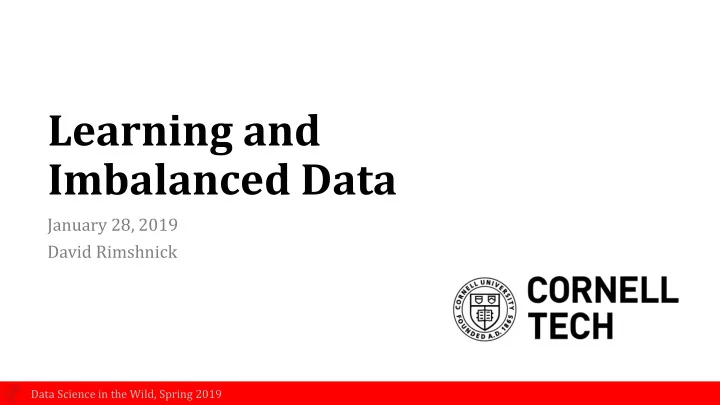

Learning and Imbalanced Data January 28, 2019 David Rimshnick Data Science in the Wild, Spring 2019
What is data imbalance? • Unequal distribution of data towards a certain characteristic • Target variable • Classification: Certain classes have much higher % of samples • E.g. Very rare disease, 99.9% of test results could be negative • Regression: Certain ranges of results much more prevalent • E.g. Almost all outputs are 0 or close to it, very few non-zero • Action variable • One of inputs (e.g. action) has very low variance in sample • Difficult for model to learn impact of changing that variable • Will revisit when we discuss reinforcement learning Data Science in the Wild, Spring 2019 Learning and Imbalanced Data 1/28/2019 2
Why is imbalance bad? • Discussion Data Science in the Wild, Spring 2019 Learning and Imbalanced Data 1/28/2019 3
What is wrong with data imbalance • Rare Disease Example: Classifier can get 99.9% accuracy by just assuming all negative! • This is also why accuracy is not the best metric • Loss function may need to be modified • Need to consider false-negative rate as well as true-positive, etc • confusion matrix , AuROC, etc – to be discussed again in later lectures • Sample may not mimic population • 90% of sample is A , but only 50% of population is • Overfitting - Model may ‘memorize’ defining characteristics of minority class instead of learning underlying pattern Data Science in the Wild, Spring 2019 Learning and Imbalanced Data 1/28/2019 4
How do we deal with data imbalance • Alter the sample • Three primary methods: • Oversampling: For under-represented class or part of distribution, duplicate observations until dataset is balanced • Undersampling: For over-represented class or part of distribution, remove observations until dataset is balanced • Synthetic Data Creation • Alter the cost function Data Science in the Wild, Spring 2019 Learning and Imbalanced Data 1/28/2019 5
Oversampling • “Random Oversampling” • Randomly duplicate records from minority class(es) with replacement until dataset is balanced • Downside: Data Science in the Wild, Spring 2019 Learning and Imbalanced Data 1/28/2019 6
Oversampling • “Random Oversampling” • Randomly duplicate records from minority class(es) with replacement until dataset is balanced • Downside: Overfitting • Model may ‘memorize’ idiosyncratic characteristics of overbalanced records as opposed to learning scalable pattern Data Science in the Wild, Spring 2019 Learning and Imbalanced Data 1/28/2019 7
Undersampling • “Random Undersampling ” • Randomly delete records from majority class(es) until dataset is balanced • Downside: Data Science in the Wild, Spring 2019 Learning and Imbalanced Data 1/28/2019 8
Undersampling • “Random Undersampling ” • Randomly delete records from majority class(es) until dataset is balanced • Downside: Loss of data! Data Science in the Wild, Spring 2019 Learning and Imbalanced Data 1/28/2019 9
‘Informed’ Undersampling • Several methods exist (see paper for reference) • Example: Edited Nearest Neighbor Rule (ENN) • Remove instance of majority class whose prediction made by KNN method is different than the majority class • Intuition: Remove “confusing” examples of majority class, make decision surface more smooth • Algorithm: 1. Obtain the 𝑙 nearest neighbors of 𝑦 𝑗 , 𝑦 𝑗 ∈ 𝑂 2. 𝑦 𝑗 will be removed if the number of neighbors from another class is predominant 3. The process will be repeated for every majority instance of the subset 𝑂 Data Science in the Wild, Spring 2019 Learning and Imbalanced Data 1/28/2019 10
Synthetic Data Creation • Instead of just resampling existing values to oversample, create artificial or synthetic data • One of best known techniques: SMOTE (Synthetic Minority Over- sampling Technique) • Algorithm: • For each 𝑦 𝑗 from a minority set, choose 𝑜 nearest neighbors • Select randomly one instance 𝑙 from nearest neighbors • Create a new instance with features as a convex combination (with some parameter 𝑞 ) of the features of the original instance and the nearest neighbor Chawla, Nitesh V., et al. "SMOTE: synthetic minority over-sampling technique." Journal of artificial intelligence research 16 (2002): 321-357. Data Science in the Wild, Spring 2019 Learning and Imbalanced Data 1/28/2019 11
Visualization of SMOTE algorithm Image Source: Beckmann, Marcelo, Nelson FF Ebecken, and Beatriz SL Pires de Lima. "A KNN undersampling approach for data balancing." Journal of Intelligent Learning Systems and Applications 7.04 (2015): 104. Data Science in the Wild, Spring 2019 Learning and Imbalanced Data 1/28/2019 12
Cost function alteration • Idea: Assign greater cost to observations from minority class 1 • E.g.: In the loss function, assign weight 𝑥 𝑗 = 𝑞 𝑗 ∗𝐷 where 𝑞 𝑗 is the sample proportion of class 𝑗 , and 𝐷 is the number of classes • Downside is that you have to edit algorithm, i.e. no longer black-box • More general framework: Assign greater weight to observations that are mishandled by model • What is this technique when done iteratively? Data Science in the Wild, Spring 2019 Learning and Imbalanced Data 1/28/2019 13
Cost function alteration • Idea: Assign greater cost to observations from minority class 1 • E.g.: In the loss function, assign weight 𝑥 𝑗 = 𝑞 𝑗 ∗𝐷 where 𝑞 𝑗 is the sample proportion of class 𝑗 , and 𝐷 is the number of classes • Downside is that you have to edit algorithm, i.e. no longer black-box • More general framework: Assign greater weight to observations that are mishandled by model • What is this technique when done iteratively? Boosting! Data Science in the Wild, Spring 2019 Learning and Imbalanced Data 1/28/2019 14
Attribution • This lecture is partially based on the following paper: H. He and E. A. Garcia, “Learning from Imbalanced Data,” IEEE Trans. Knowledge and Data Engineering, vol. 21, issue 9, pp. 1263-1284, 2009 Data Science in the Wild, Spring 2019 Learning and Imbalanced Data 1/28/2019 15
Recommend
More recommend